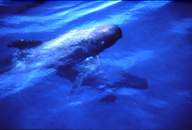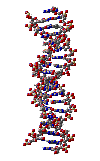|
Caught by the past – how a new ecological theory is challenged and new conservation areas for coral reefs are necessary (03/2006)
An extensive study on the Indo-Pacific coral reefs, about to be published in the 2nd of March issue of the journal Nature1 challenges the present conservation protocols for these organism and calls for important changes in the way that protected areas are being established all over the world, in order to be able to stop the present (fast) rate of extinction observed in coral reefs.
A major ongoing discussion in ecology is what determines the biodiversity (which species and in what abundance) of a community. To the Darwinian theory of natural selection, in order to co-habit, different species have to occupy different living environments (also called ecological niches). Because, if they compete, for example, for space or food, inevitably only one of the species will survive – this is known as the “survival of the fittest”. However, some ecosystems, like coral reefs, have such an incredibly large biological diversity that is difficult to be explained by the “niche” model.
The Neutral Theory of Biodiversity is a controversial and exciting new ecological model that tries to explain how these high diversity ecosystems can occur, and which claims that co-habitation of different species in a particular environment is simply the result of a random migration into the same habitable region. According to this model, differences between similar groups of species living in an ecological community can be considered "neutral" or irrelevant to their success. This means that, if for example one species of bird seems to be better suited to a particular environment, this should not increase its odds to survive in that environment in comparison to another bird species. In this way, biodiversity results solely from random fluctuations in processes such as migration, birth rate, death, etc.
Although many ecologists believe that the theory is oversimplified when it ignores the “survival of the fittest” paradigm, the reality, is that the model has been successfully applied to a variety of ecosystems including forest trees, birds, frogs, moths and many others. In consequence, critics have not been able to dismiss it and the neutral theory continues to be the centre of much attention and debate.
But now Maria Dornelas, a Portuguese scientist, together with Sean R. Connolly and Terence P. Hughes at the ARC Centre of Excellence for Coral Reef Studies and School of Marine Biology and Aquaculture, James Cook University, Townsville, Australia decided to test the feasibility of the neutral theory on a large number of coral communities within similar environments in the Indo-Pacific Ocean. Coral reefs, due to their life cycle and high biodiversity, are considered the perfect example to be explained by the neutral theory and, due to their present fast rate of extinction, are in urgent need of being better understood.
According to the neutral theory, different coral reefs should be more and more dissimilar as distance between them increases, since the closer two communities are, the higher is the probability of having the same migratory populations. The “niche” model, on the other hand, predicts that the corals communities will be much more similar between themselves than what is expected by the neutral theory, since they have comparable living environments. With two such conflicting predictions Dornelas, Connolly and Hughes just had to compare the data collected from the Indo-Pacific coral reefs with the values predicted by the two theories and see which one conformed more to the observed results.
Unexpectedly, the team of scientists found that the coral communities not only were very different from what was predicted by the neutral theory, but, were also not similar to the values obtained through the “niche” model. The level of variability found between different coral communities was, in fact, much higher than any of the models predicted and pointed to the existence of some unknown factor capable of radically change biodiversity in these communities.
“Not only did we find that the neutral theory didn’t work,” says Dr Connolly, “it failed in a completely unexpected way, totally different from what critics of the neutral theory had been expecting. By looking closely at how and why the theory failed, we gained some new insights into how coral reefs sustain so many species.”
The researchers believe that the high variations in biodiversity found between the different communities are the result of environmental changes over time, as even nearby coral communities can have totally different environmental histories. This unexpected high levels of biodiversity between communities challenges present approaches to coral reef conservation. In fact, now, the priority, when establishing a new conservation zone is to conserve all the different niches which are assumed to contain all the possible biodiversity. With these new results, researchers realise that different environmental history create unique biodiversities that are almost impossible to predict. In result, the only way to avoid coral reef extinction is by enlargement of the conservation areas in order to allow a variety of environments to be available, in case environmental disturbances occur.
“Most marine protected areas around the world are too small and too isolated to preserve the links between populations on different reefs. This increases the risk that a rare group of animals could go extinct unless they can colonise a more favourable reef,” says Professor Hughes.
“Protected areas need to be close enough for marine life, including coral spawn, to flow freely between them, to give the corals the best chance of preserving their unique biodiversity as the environment changes” Maria Dornelas says. “This will entail enlarging some areas and adding new ones in order to ensure long-term recovery from extreme conditions, such as cyclones, coral bleaching and human impacts on water quality.”
The study by Dornelas, Connolly and Hughes not only challenges conservation attitudes but also the Neutral Theory of Biodiversity that when tested in coral reefs – supposedly the perfect example of a high diversity population– simply does not work, what gives its critics a surprisingly boost. Nevertheless, Dornelas, Connolly and Hughes emphasise that although probably not a theory that can describe ecological communities, the neutral theory still has a role when used to test different ecosystems informing on the importance of the different parameters assumed as neutral by the model, as this study clearly proves.
Piece researched and written by: Catarina Amorim ( catarina.amorim@linacre.ox.ac.uk)
 1 Nature 2nd March 2005 1 Nature 2nd March 2005
"Coral reef diversity refutes the neutral theory of biodiversity”
Original paper’s authors
Link to the original paper - http://www.nature.com/nature/index.html
|
In collaboration with the Observatório da Ciência e do Ensino Superior (OCES)
Financed by the Fundação para a Ciência e Tecnologia (FCT) |





